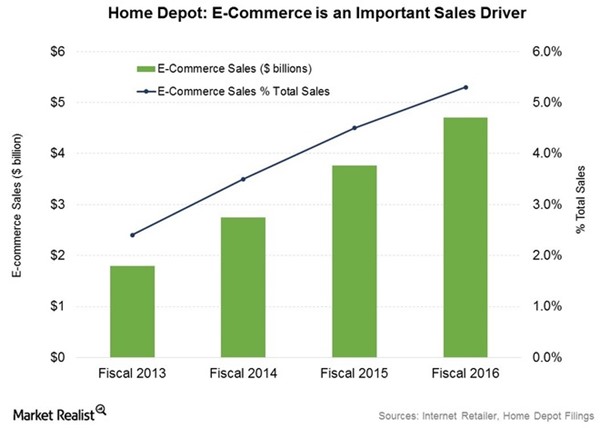How Home Depot Nails Omnichannel Supply Chain Fulfillment
The Home Depot, the biggest home improvement retailer in the United States, and number 4 on the National Retail Federation’s top 100 US retailers
list. And it’s no wonder – the company operates big-box format stores averaging 105,000 square feet (though the largest, found in New Jersey, measures in at a whopping 225,000 square feet) across the whole of North America, including all 50 US States, Puerto Rico, the District of Columbia, the United States Virgin Islands, all ten provinces of Canada, and Mexico.
A widespread presence doesn’t always equal success, but it most certainly does in the case of Home Depot – but one key driver is the ground that the retailer has made in ecommerce.
Home Depot reported ecommerce sales
of $4.7 billion in fiscal 2016, an increase of 25%, or nearly $1 billion, year-over-year. In fiscal 4Q 16, Home Depot’s web sales came in at $230 million – up 23% year-over-year.
The question, then, is what is the secret to the retailer’s online success?

(Image source: Market Realist
)
Home Depot’s Omnichannel Supply Chain Fulfillment
Digital is unequivocally Home Depot’s fastest-growing business, but online sales growth is actually being facilitated via the company’s bricks and mortar store network. Indeed, around 40% of Home Depot’s digital sales are fulfilled by physical stores.
The result is not so much an out-and-out ecommerce success story, then, but rather an omnichannel one. The Home Depot retail strategy has emerged as one that combines elements of both bricks-and-mortar and digital channels to drive sales growth.
The fulfillment options that Home Depot currently offers are BOPIS (buy online pickup in-store) and BORIS (buy online return to store), and buy online ship to store omnichannel fulfillment options. In 2016, Home Depot also plans to roll out a further BODFS (buy online deliver from store) option, which will enable the retailer to fulfill online orders directly from stores – a strategy that also enables next day delivery within a two-hour window.
Removing the “E” From Ecommerce
Every online shopper at Home Depot is asked a very simple question: “Would you like to pick this up in the store or have it delivered?”
However, the process of building a distribution network that can accommodate both answers to this question for every customer every time has not been achieved over night – and indeed, there is still some miles to cover before such fulfilment becomes 100% effective every single time.
Nevertheless, Home Depot’s omnichannel supply chain fulfillment strategy is exemplary – and it hasn’t just been built via a greater focus on accommodating the rapid growth of its ecommerce capabilities. Rather, that Home Depot has restructured its whole supply network in order to integrate the experiences of in-store and online commerce.
Home Depot recognizes the customer value of online inventory visibility and product research, and has transformed its online store to better facilitate these needs. But, most importantly, it is in the restructuring of its fulfillment network that has made the retailer’s digital sales so successful. Home Depot has developed and deployed a network of distribution centers that furnishes both direct-to-customer fulfillment orders and store replenishment, which of course serves BOPIS and BODFS avenues as well.
Scott Spata, Vice President of Supply Chain Direct Fulfillment at The Home Depot, says that the company likes to think of all of its transaction processes as fulfillment, no matter how the goods get to the customer:
“In fact, we prefer to take the ‘e’ out of e-commerce and just call it commerce,” he says. “A high number of in-store transactions start online, where we can drive customers to the store armed with all the information they could need. Alternatively, they might want to see and touch a product in a showroom before ordering a specific size or color online. However the customer wants to transact, we’ll make it happen on the back end.”
Investing In Fulfillment
Future plans for Home Depot do not (at present) include the building of new US stores. Instead, investments are being made to existing stores in order to double them up as fulfillment centers to drive further omnichannel sales. Furthermore, the company has invested in three direct fulfillment centers (DFCs) – one in California, another in Georgia, and a third in Ohio – to enhance shipping speeds. According to Market Retailer, Home Depot is now able to guarantee two-day parcel delivery to 90% of the US population.
Speaking at the 37th Annual Raymond James Institutional Investors Conference
in March this year, Home Depot’s Senior Vice President and President of Online Business Kevin Hoffman laid out the company’s vision going forward. I give the final word to him:
“You got to have a great mobile property, great tablet experience, great PC experience, great virtual experiences coming together with 2,200 stores, a full supply chain with multiple distribution centers across the whole country, over 350,000 associates, a tremendous assortment of goods and products that you can bring to bear in front of the customer, and then centralized associates and contact centers,” he said.
“So all of those physical assets and the new virtual assets that we bring together [come] together in a symbiotic way to solve for the customer experience. That’s our term of interconnected retail.”
![]()
About John Waldron: John Waldron is a technology and business writer for markITwrite digital content agency, based in Cornwall, UK. He writes regularly across all aspects of marketing and tech, including SEO, social media, FinTech, IoT, apps and software development.